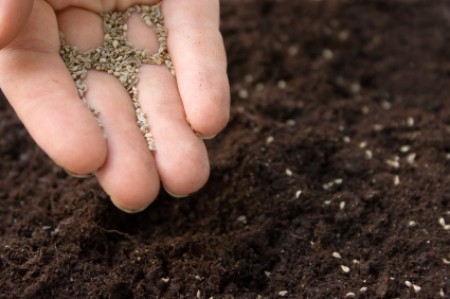Direct sowing means planting seeds in the soil where you want them to germinate and grow. This is the simplest and most direct method for growing many types of flowers and vegetables - especially those that don't transplant well. Sowing seeds directly isn't difficult, but the right soil conditions, temperature, and moisture can be key factors in determining your success.
Healthy soil is truly the foundation of successful gardening. Before sowing your seeds, amend the soil with generous amounts of organic matter including compost and well-rotted manure. Remove rocks and large clumps of soil. Smooth garden beds with a rake until the soil is broken down into small, even-sized particles. Avoid working the soil when it's too wet, as this can cause compaction and destroy the structure of the soil.
There are three main ways to sow seeds: in rows, in drills (stations) or by broadcast sowing. Sowing seeds in rows or drills are good methods to use if you want to grow lot of plants, but keep each type of plant in its own row. Broadcasting seeds means scattering them broadly, but evenly over the surface of the soil. This is a good method to use when you have a large amount of seed and want to create large drifts or random mixes of color.
Most seeds do not need to be buried deeply to germinate. A depth of 1/8 inch for small seed is usually sufficient. Large seeds can be planted at a depth twice their diameter. Always read and follow seed packet recommendations. If you plant seeds deeper than indicated on the packet, the seeds may not contain enough energy for germinating seedlings to reach the surface.
Sowing in rows: Some seeds are best sown in rows. To make the rows straight, tie a string between two stakes. Following the string line, run a how through the soil to dig a trench of the proper depth for the seeds you're planting. Set the seeds in the trench at the proper spacing then cover the seeds with soil.
Sowing in drills (stations): In this method, seeds are sown in individual holes and at the final spacing required for growth. This method cuts down on the amount of seed you use and works well for plants that need a lot of room to grow. Two or three seeds can be sown in each "station" (hole), and then thinned down to one as seedlings emerge.
To sow in drills, mark out rows with a stick or the back of a hoe. Use a dibble or the tip of a pencil to poke small holes into the soil, and then drop in the seeds and cover them with soil.
Broadcasting seeds: The broadcasting method offers the insurance of sowing extra seeds. Using your hand, scatter the seeds as evenly as possible over the entire planting area. Mixing them with a small amount of fine sand will add some weight and help them scatter more evenly. Expect to do a bit more thinning when using this method.

About The Author: Ellen Brown is an environmental writer and photographer and the owner of Sustainable Media, an environmental media company that specializes in helping businesses and organizations promote eco-friendly products and services. Contact her on the web at http://www.sustainable-media.com
Add your voice! Click below to comment. ThriftyFun is powered by your wisdom!
I never would have thought about snipping the extras out, what a good Idea! Thanks for the info! I see that most seeds don't need to be planted as deep as I have been planting mine....glad to know this!
Add your voice! Click below to comment. ThriftyFun is powered by your wisdom!